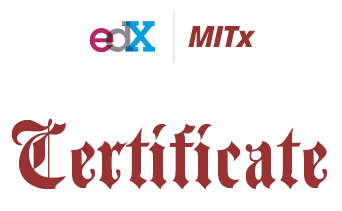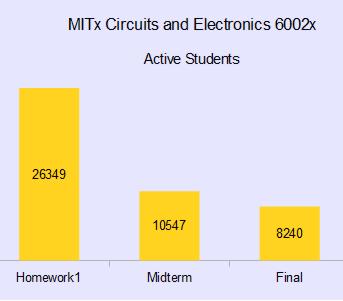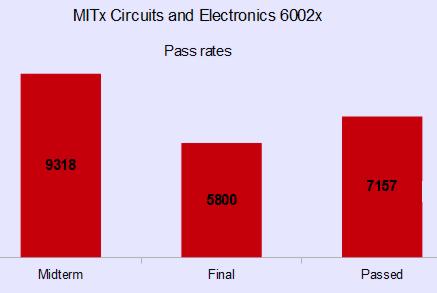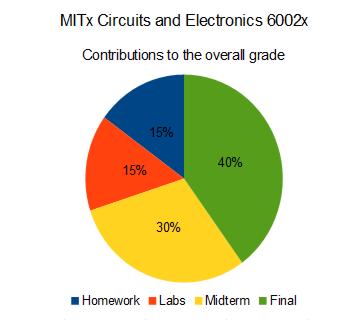| MITx - The Fallout Rate |
| Written by Sue Gee |
| Saturday, 16 June 2012 |
|
Dropout rates are a concern for concrete universities.When a student fails to complete a course they signed up to it's bad - for the student, for the teacher and for the institution. Is it any different for a virtual MOOC? MITx has completed its one and only MOOC (massive open online course) which attracted over 150,000 sign-ups. The certificates have been issued to those who passed - 7,157 students - and participants have also been privileged to know the course statistics. Let me hasten to add the fact there won't be any other MITx courses is only because a couple of months ago MIT and Harvard joined forces to create edX and if fact the rather impressive-looking certificates issued to those successfully completing Circuits and Electronics, 6.002x features both edX and MITx logos: Anyway back to the course statistics and what they mean:
That's impressive - it's almost as many as Sebastian Thrun and Perter Norvig's record breaking statistic of 160,000 for the AI Class.
If you just look at the number of certificates issued as a proportion of the enrollment number that doesn't look impressive. It's only a 5% pass rate. By way of comparison for a MOOC the AI Class with 23,000 certificated students achieved a 14% pass rate. Should we be worried about the dropout rate? This question is particularly important in view of the fact that for its next course, Intro to Statistics, Udacity it looking to exceed the record for enrollments set by the AI class, So let's consider where the drop-off happened, as illustrated in this chart:
In other words, 55% had already dropped out either before the course started (and some of this will be accounted for by people enrolling with multiple e-mail addresses) or when they discovered its level. Here I have to raise my own hand. I've dabbled in a bit of electronics and was keen to try out a "real course". This one was obviously way beyond my level, as was revealed within only a few hours
In other words of the original signups perhaps only 17% went on to ctively engaged in the course having discovered that it was going to be too difficult, too time consuming or just not for them. But if you look at it from a "glass half full perspective" 26,349 students expressed enough interest in electronics at advanced undergraduate (or some would argue postgraduate) level to get this far. And so the message for MOOCs has to be to aim for high numbers - you can't complete any course unless you at least enrol - and don't stress to much about a high attrition rate. If only a small proportion run the race and cross the finishing line, it is still a great achievement. Turning back to MITx, students who gave up early in the course had made a minimal investment - and hopefully the fact that such a large number had made this much effort will encourage edX to provide a preparatory electronics course at a lower level. Another point that's worth making about the seeming marked dropout rate, at it also explains the number of people who looked at the exams and didn't even attempt to do them, is that this course will have attracted a huge number of onlookers - students on other courses looking to see how it compared to their own and other teachers who wanted to pick up tips - especially in view of the fact that some of the courseware is available for them to use. To quote more of the statistics:
Let's now look at what happened to "active" students - i.e. the more than twenty-six thousand who tried the Week 1 homework:
Again there was a marked drop out by the midterm (60%) but the dropout between those who attempted the midterm and those who attempted the final was much less (22%). One of things you have to remember is that this course had a high level of difficulty throughout but there was a real ramp up with the exams, which while still open-book only gave your three chances to get multi-part questions completely right. And if students were expecting the final to be easier than the mid-term they were in for a big shock. If you want to know more about this see Harry Fairhead's account of the course and its exams. And what happened to the people who "sat" the exams:
Of those who attempted the mid-term 88% passed but the pass rate for the final exam was only 70%. However more students actually passed the course that passed the final. This was because of the weighting given to different elements in the course:
This means that you could pass the entire course by doing well in homework and labs and either acing at one of the exams or by sitting both and getting enough points to make up 60 points in total for a C grade. Those who were awarded a B needed to pass all elements and for an A, requiring 87 points overall, you had to do well on both exams. At the end of the day what is important is that a massive number of people studied a hard and exacting electronics course and:
Over seven thousand of these certificate have been issued. This is a massive achievement, both for the individuals who have gained them, and for MITx/edX, both of which are under the directorship of Anant Agarwal who also taught 6002x. And the message for MOOCs has to be disregard the dropouts and celebrate giving huge numbers of people access to free, high-quality, education.
Related ArticlesMITx Experimental Course Completed - A Report On Statistics and Open Education: A Brief Chat with Sebastian Thrun
To be informed about new articles on I Programmer, sign up for our weekly newsletter, subscribe to the RSS feed and follow us on Twitter, Facebook or Linkedin.
Comments
or email your comment to: comments@i-programmer.info
|
| Last Updated ( Wednesday, 30 June 2021 ) |






